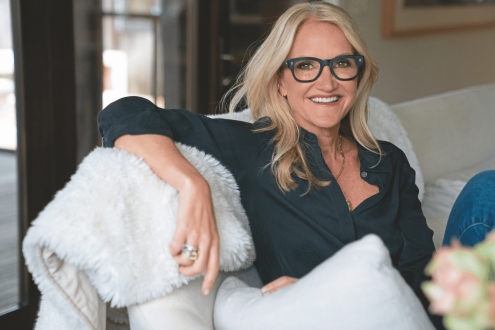The real brain training game
Determined to find a permanent solution to her ulcerative colitis, Beverley D'Silva seeks to cure the root cause - deep inside her brain

Imagine there was a technique that could help you sleep better, that sharpened your concentration, calmed you down and lifted your mood? That relieved anxiety, depression and addiction, helped ADHD and post-traumatic stress disorder, and eased dementia, Alzheimer’s disease, and the risk of strokes and seizures? And, not only that, it was holistic, non-invasive, safe and drug-free? I believe that there is. It’s called neurofeedback, and it works by training that vital – yet often overlooked – organ: your brain.
I first stumbled upon neurofeedback (NF) in a web post* by Psychologies health columnist, Dr Andrew Weil. Writing about ulcerative colitis (UC), he advocated biofeedback, a method of controlling inner functions that are normally outside of our control. Biofeedback’s offspring, I discovered after some further digging, was NF. I got excited reading about the overwhelmingly positive results, reported by people who had tried it.
Having battled with UC for years, I’d tried many remedies – allopathic drugs, dietary changes, acupuncture, homeopathy, Vedic meditation and EFT, or tapping. Most hadn’t harmed me (except allopathic drugs; steroids are no walk in the park), but they hadn’t restored me to optimal health either.
Despite the positive emerging research, NF is not new: it was discovered by doctors in the US in the 1960s and adopted by NASA, which used it to stop astronauts having fits from exposure to rocket fuel (the space agency still uses it). In the US, it is an approved diagnostic tool and treatment for ADHD, and used for traumatic brain injury and PTSD, as well as for any brain-based functional conditions (strokes and autism) and emotional conditions (depression, anxiety, and childhood trauma). In parts of Europe, such as Germany and Scandinavia, one can have it on state healthcare.
Here, awareness of NF is slowly growing, pioneered by forward-thinking companies such as Brainworks, whose co-founder, James Roy, describes it as ‘yoga for the brain’, because it can increase mental flexibility. At the firm’s London clinic, I meet neurotherapist, Christina Lavelle. After taking my medical history, she hands me a cap wired to a computer and lined with sensors. Once I’m wearing the cap, the sensors detect electrical impulses (my brain activity), displayed on a screen. ‘Once we can see what the brain is doing,’ says Roy, ‘we can set goals for it to meet.’
Asked what I would like to change, I say I would like to heal my UC. I had heard that the Royal College of Music and Chelsea Football Club use NF on students and players to enhance physical co-ordination, performance and focus, so I add hopefully, ‘Could I have concentration superpowers, too?’ It’s a bit of an ask – but who knows? First, Lavelle does a ‘Q’,a computerised map of my brain, which reflects my emotional and cognitive states. A perfect Q would be white. Mine has messy splats of colour, indicating inflammation (core UC territory), anxiety and negative internal ‘chatter’, or scripts. I wish I had started those positive affirmations by Louise Hay… I also have an overactive limbic system (which governs instinct and mood); this would have a big effect on the gut, I’m told. My goals will include calming down my fight-or-flight response, and reducing stress and busy beta brainwaves (‘fast’ activity, present when we are alert, attentive, engaged in problem-solving, judgment, decision-making and focused mental activity).
The training itself is a doddle. You simply sit back and watch a film – but not a regular film. It plays for a bit and keeps pausing. Good brain activity is rewarded with its continuation, and inefficient brain activity makes it stop. As my brain learns how to keep the movie playing, the targets are made more difficult. In this way, I learn how to quiet activity associated with low performance and increase activity associated with optimal brain function. ‘So, if your brain is endlessly doing something not very efficient, or uncomfortable, this is how we show you the route out of it,’ says Roy.
As NF operates on ‘classical conditioning’ – unconscious behaviour can be learned by rewarding it – it works well for very young children, as well as adults.
Calming the chaos
Nicole Fruth, 26, wishes that she had found NF when she was much younger. She grew up in Arizona, in a chaotic home, with parents who were often fighting. ‘I developed OCD issues, I would be hand-washing and tidying up, doing actions over and over again. It was like my brain got stuck in a gear and couldn’t get out. Everything had to be perfect and, if it wasn’t, I suffered terrible guilt.’
Medics prescribed Ritalin, normally used for ADD, and a medication that, she feels, made her worse. ‘Outwardly, I seemed OK, but inside I was scared.’
Having struggled through her teens, in her early 20s Nicole moved to England to study at the London School of Economics. It was around that time that she realised she wasn’t enjoying the quality of life she wanted. ‘I was good as ever at appearing to be successful, but my emotional world was in tatters. I had no confidence, I couldn’t focus, and socially I was a nervous wreck.’
Nicole was struggling with her studies, and a long-term eating disorder got worse. ‘I stopped eating. I was far too thin. I was punishing myself.’ She was also being damaged emotionally by the man that she was dating. ‘I was intimidated by him and afraid of him, but I didn’t have the courage to leave,’ she says.
Nicole began psychotherapy and her therapist suggested that she try NF with a practitioner. ‘After just three or four sessions, I felt calmer. It was as if my brain was working so much better. I was solving maths problems and saying to myself, “Is this really me?”’
She had 25 sessions. ‘The difference after those was amazing. I went from struggling in accounting to getting a very high merit. I joined a support group for people with eating disorders, and my weight went back to normal,’ she says. She also found the courage to leave the man who’d made her unhappy. ‘I feel the training gave me the courage to walk away.’ She’s since started seeing someone else and says, ‘He hasn’t seen that old OCD part of me, because it isn’t there any more. Neurofeedback changed my attitude, which changed everything for the better.’
One negative was that her sleeping patterns were disturbed during training. ‘Normally, I sleep like a log – but if I suffered a little, it was worth it for the payoff, and my sleep normalised once training stopped. I don’t regret it at all.’
Restful slumber
Conversely, insomnia had plagued Anne Watts for so long that it had become her ‘normal’. Anne, 47, had strict rituals associated with sleep: her bedroom had to be very dark, and she only felt comfortable sleeping in a familiar bed. ‘It made going on holiday hell – it was always a week or two with virtually no sleep,’ she says.
Even at home, she rarely slept through the night. Anne suffered frequent bouts of anxiety that she had assumed were ‘genetic’, as her mother had been an anxious type. She’d tried many remedies for her issues, from country walks to taking fish oils and magnesium, but none made a real difference. She was advised to try meditation. ‘I found that impossible,’ she says. ‘I’d sit and my mind would be racing. No matter how hard the teachers tried with me, I couldn’t switch off.’
Anne’s son, who she describes as ‘on the autistic spectrum’, was having NF and had responded very well. She asked his trainer, neurotherapist and psychiatrist, Dr Freddy Starr, if it could help her, too. Dr Starr asked Anne whether she’d had a traumatic brain injury (TBI). ‘I’d been in a car crash at 17, while on holiday in the Bahamas. My head hit the windscreen and I was unconscious for six hours,’ she says. She’d never had a brain scan, however; when she did, it showed the TBI. Anne started NF, while also following an anti-inflammatory diet, and avoiding allergens, ‘Many of which were the foods I craved – so it was no longer wine o’clock for me,’ she jokes.
After two sessions of NF, Anne says her sleep improved so much that she was sleeping deeply and waking refreshed. After 12 sessions, her TBI had gone right down on the scale. ‘I can now meditate too,’ she says.
While Anne certainly benefited from NF, she stresses the role that other therapies – such as hyperbaric oxygen therapy and healthier living – played in her recovery, as well as her own diligence. ‘My sleeping is great now, providing I don’t drink too much wine and I go to bed at a sensible time.’
One of Starr’s main goals is to reduce people’s reliance on conventional drugs and he maintains a holistic approach in his practice; he advocates Anapanasati meditation (focus on the breath), yoga, nutritional balance and traditional medicines, alongside NF brain training.
As to the reported side effects of NF, these have been minimal, and the US Food and Drug Administration has approved it as safe. There have been no major, double-blind, placebo controlled studies of NF, as is the way with many alternative and holistic approaches (companies financing medical research would fi nd it hard to recoup their investment in relation to NF in the way they could with conventional drugs).
The latter fact has been the main sticking point for detractors, such as US psychologist Robb Mapou, who remains sceptical about NF, and says, ‘I haven’t seen enough rigorous studies in most conditions for which it is recommended to show, definitively, that neurofeedback is e ective. I think there are other therapeutic factors that can contribute to an individual’s outcome, such as discussing their problems with a therapist.’**
Michelle Harris-Love, a US neuroscience researcher at the MedStar National Rehabilitation Network in Washington, agrees. ‘I believe it is applied in some situations where we do not have enough information on the cause of a disorder or how recovery happens.’**
Striking the balance
For me, the main drawback with NF is the cost – between £100-£140 per hour-long session. ‘Around two thirds, or 67 per cent, of people will experience vast improvement after 10 hours’ training; 95 per cent will experience that after 20 hours,’ says Starr. In cases of autism or where learning is impaired, 40 or 50 hours may be appropriate. While changes are lasting, it may be desirable to ‘top up’ later. As for me, after 12 sessions, the inflammation on my earliest Q had reduced to a third of what it had been. Accordingly, as my UC symptoms had calmed down, so had my mind. Situations that would once have been irritating or upsetting to me didn’t have the same edge. But, like Anne, I continued to work on myself in other ways: reducing my stress, cutting out alcohol, going on a serious residential cleansing retreat and eating a wholesome diet.
There have been unexpected, positive ripple e ects, too – my dancing and co-ordination have improved and, most recently, after 12 Skype sessions – which I highly recommend – I feel like I do literally have a new superpower of concentration and focus. Now, that is a happy ending.
British companies that offer neurofeedback
- Brainworks has a practice in London, and also o ers home training using remote units. It runs NF retreats in the UK and France, as well as in Costa Rica. Visit brainworksneurotherapy.com or call 020 7193 4373.
- BrainTrainUK has several brain training treatment clinics located in London, Surrey, Kent, Hertfordshire and Buckinghamshire. Visit braintrainuk.com or call 020 7978 0186.
**Washington Post, 2015
Photograph: iStock









